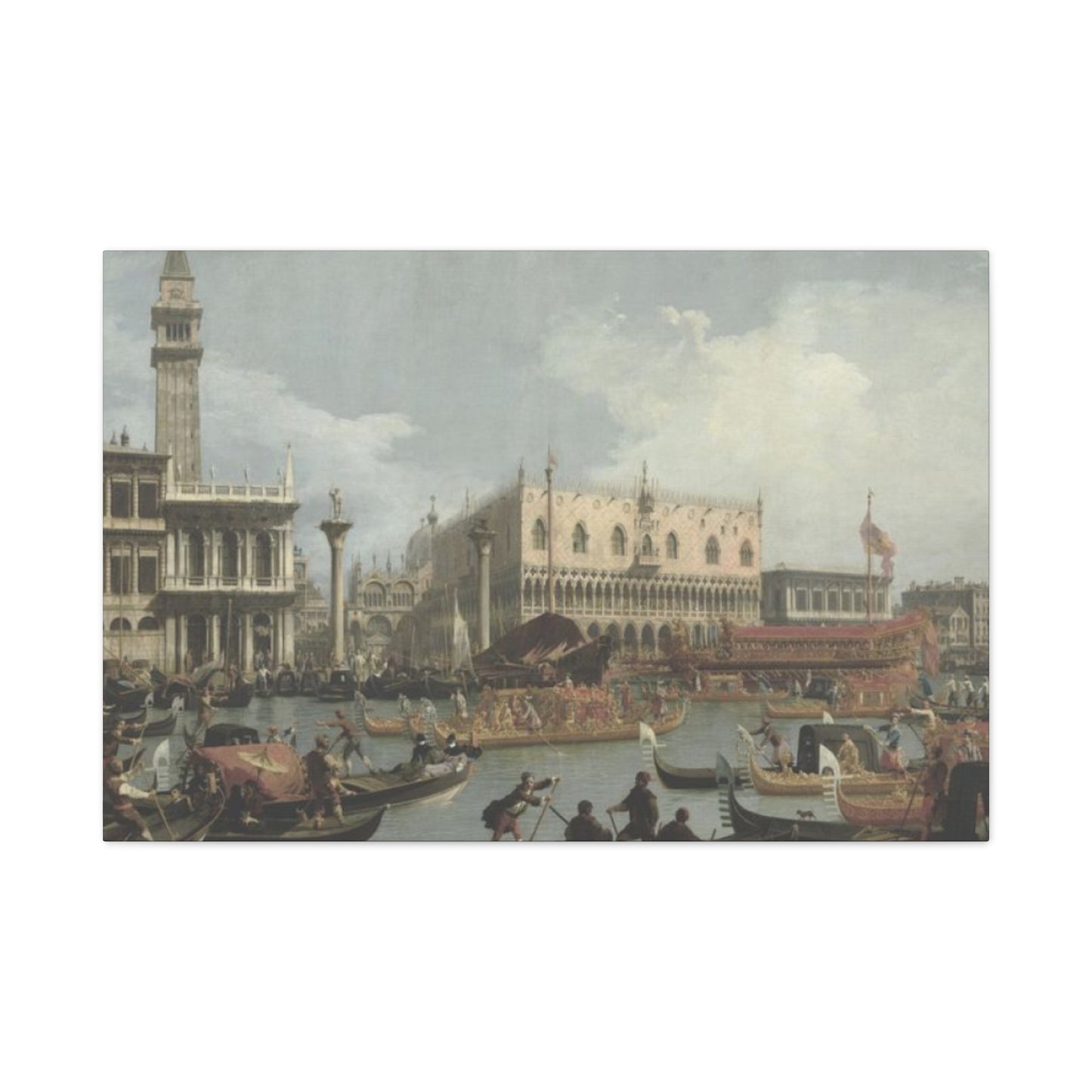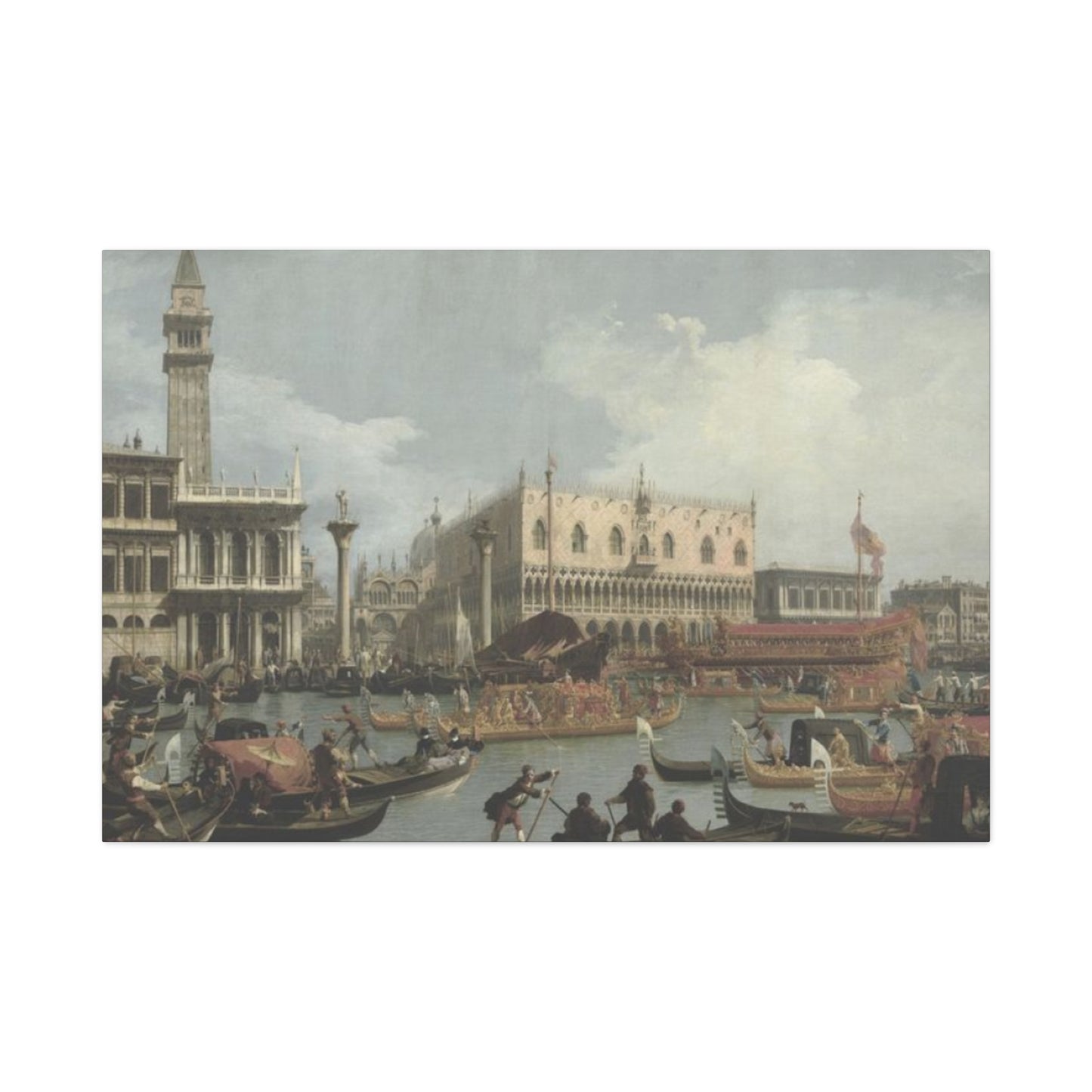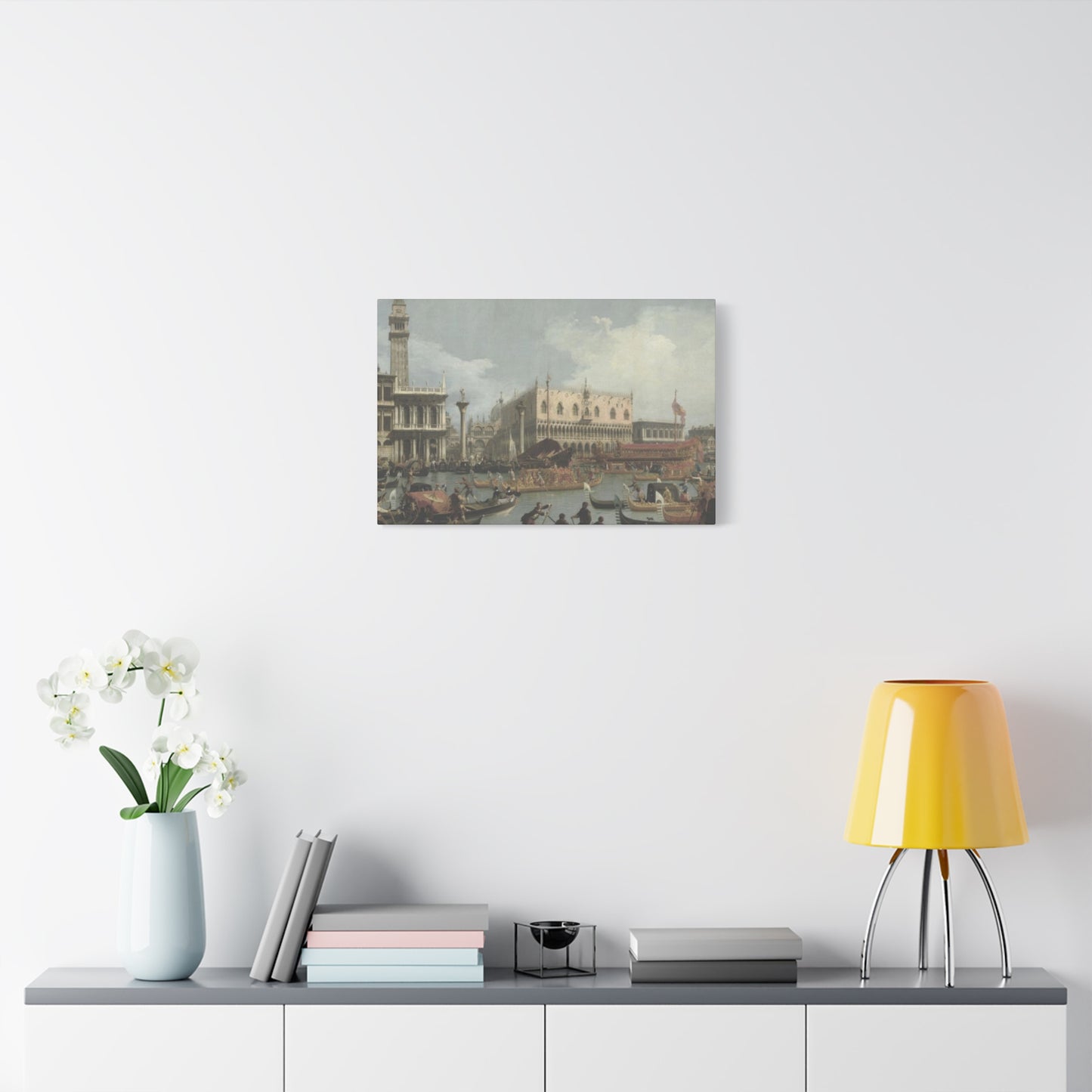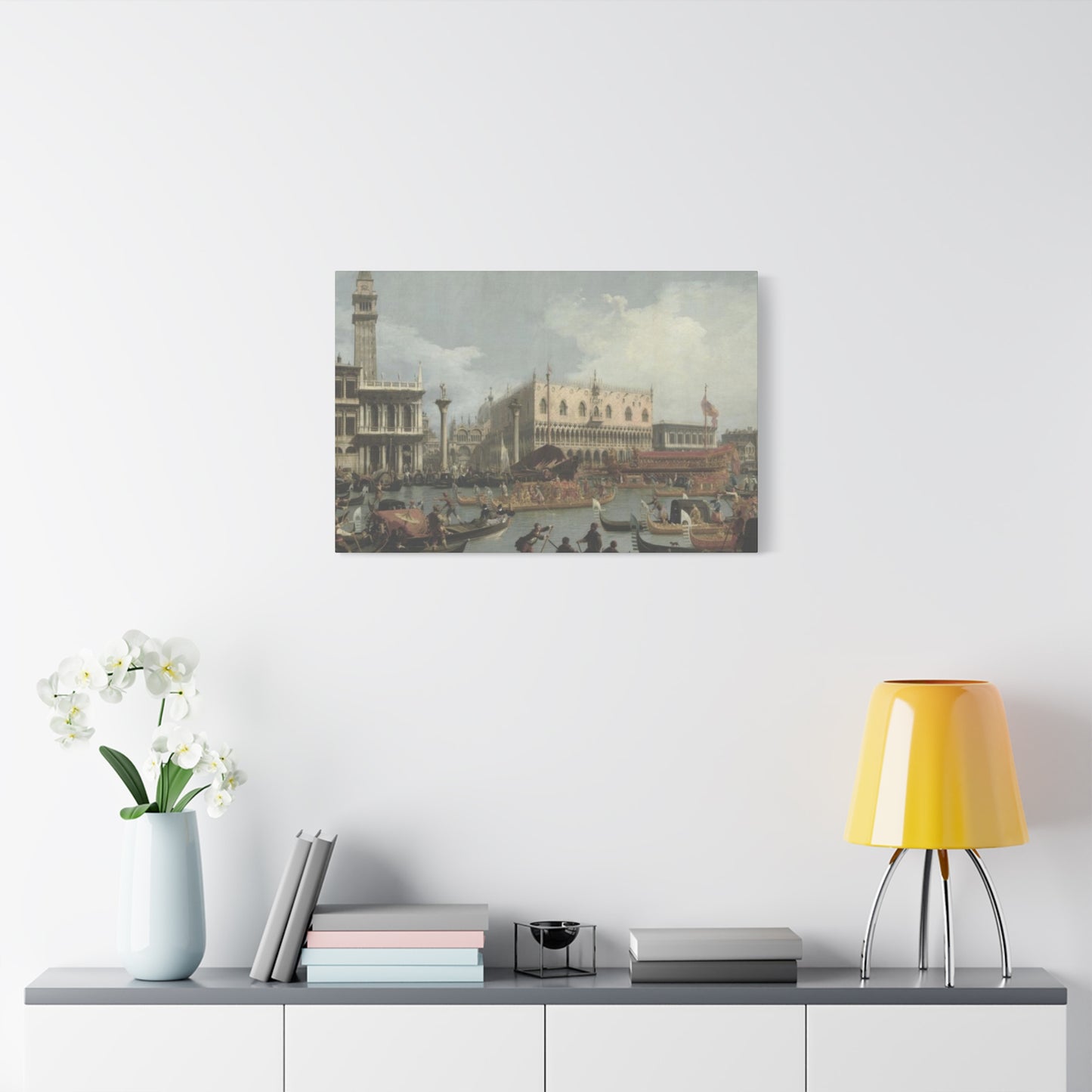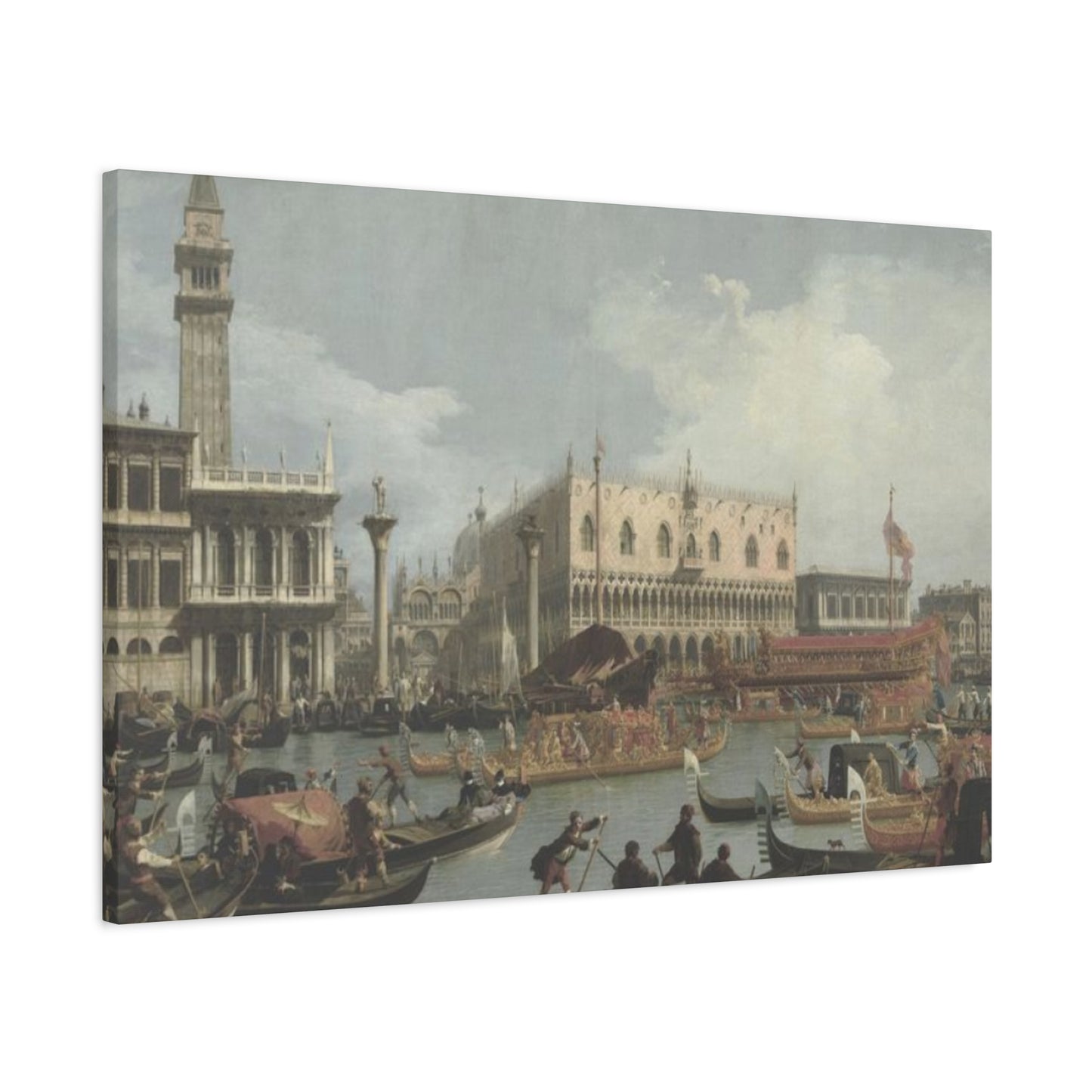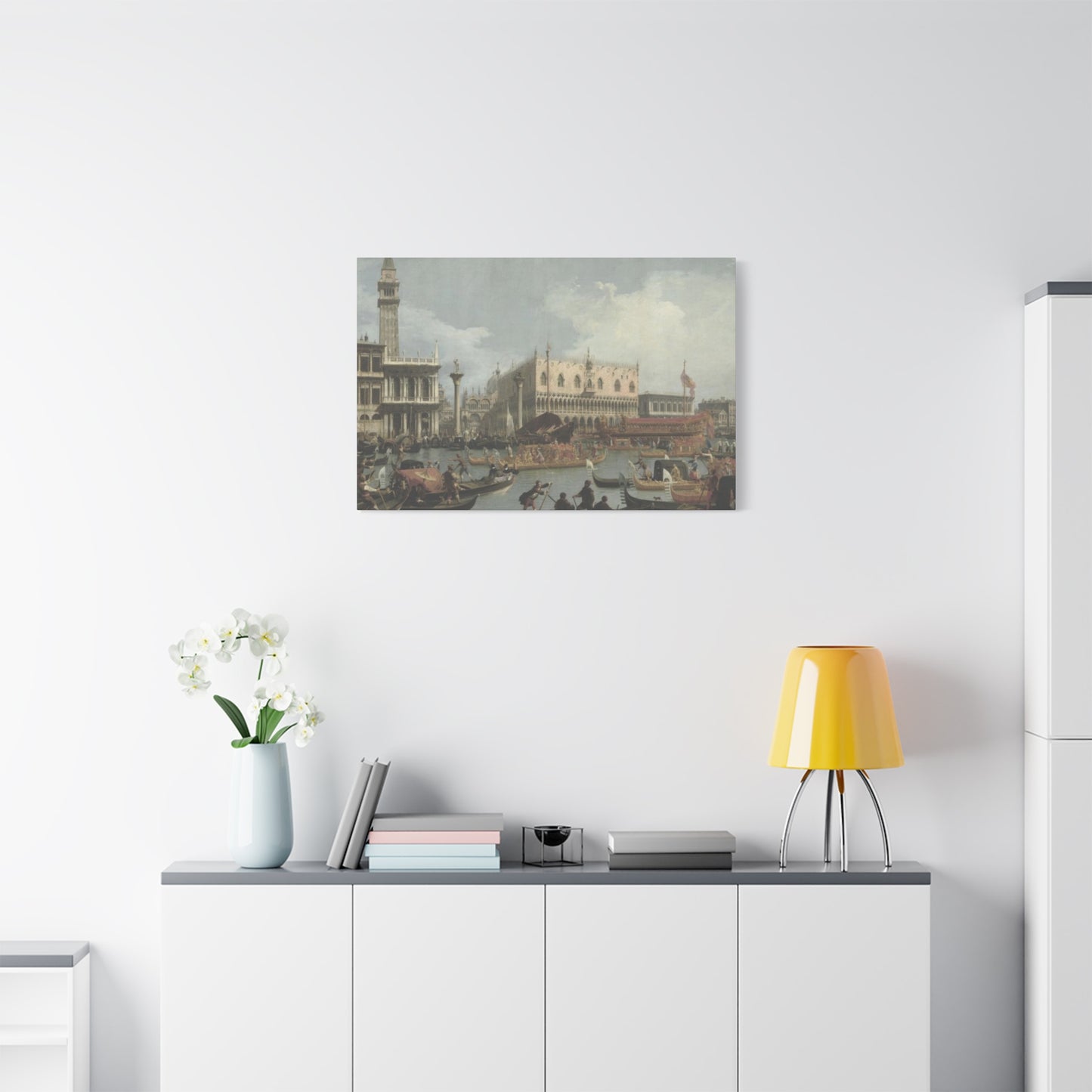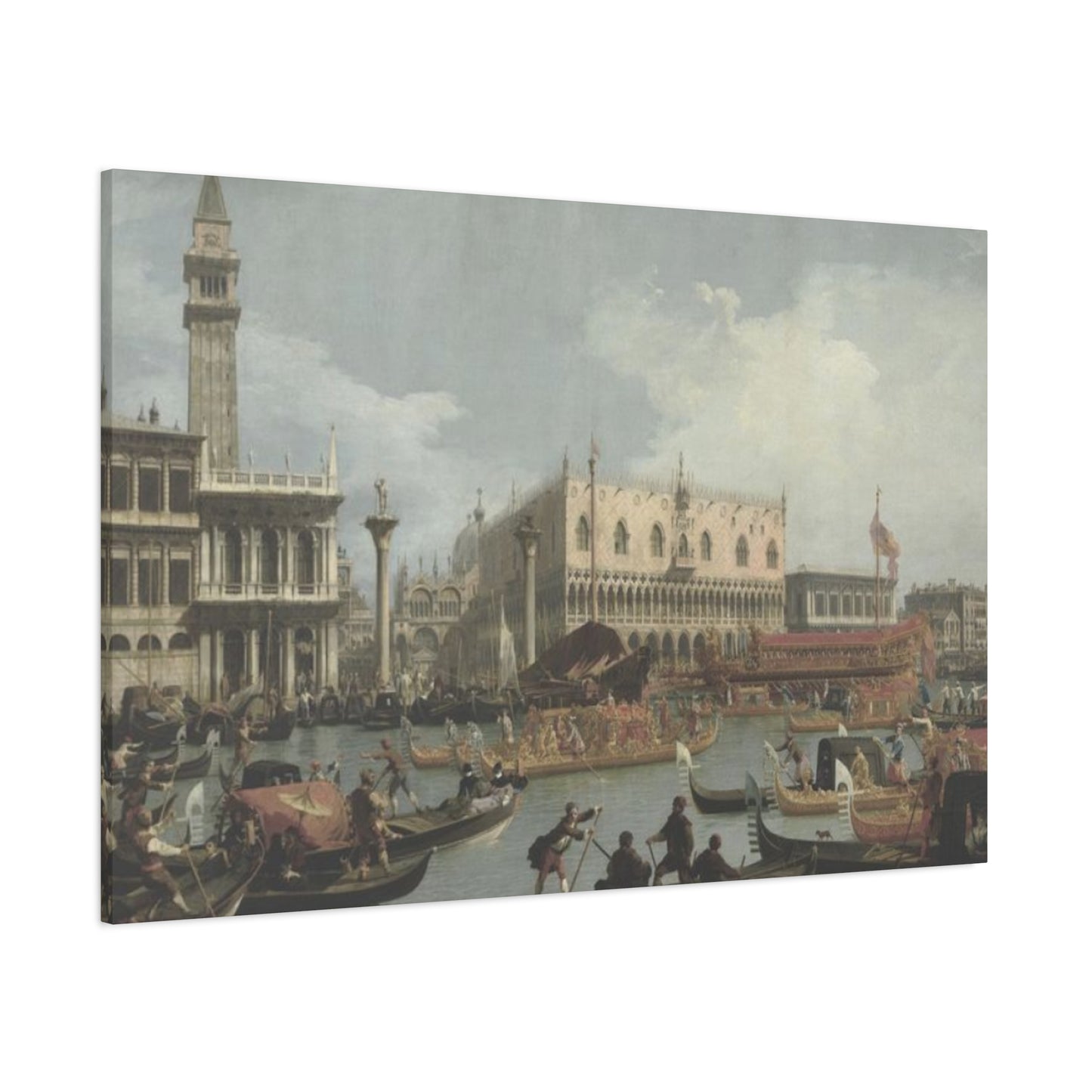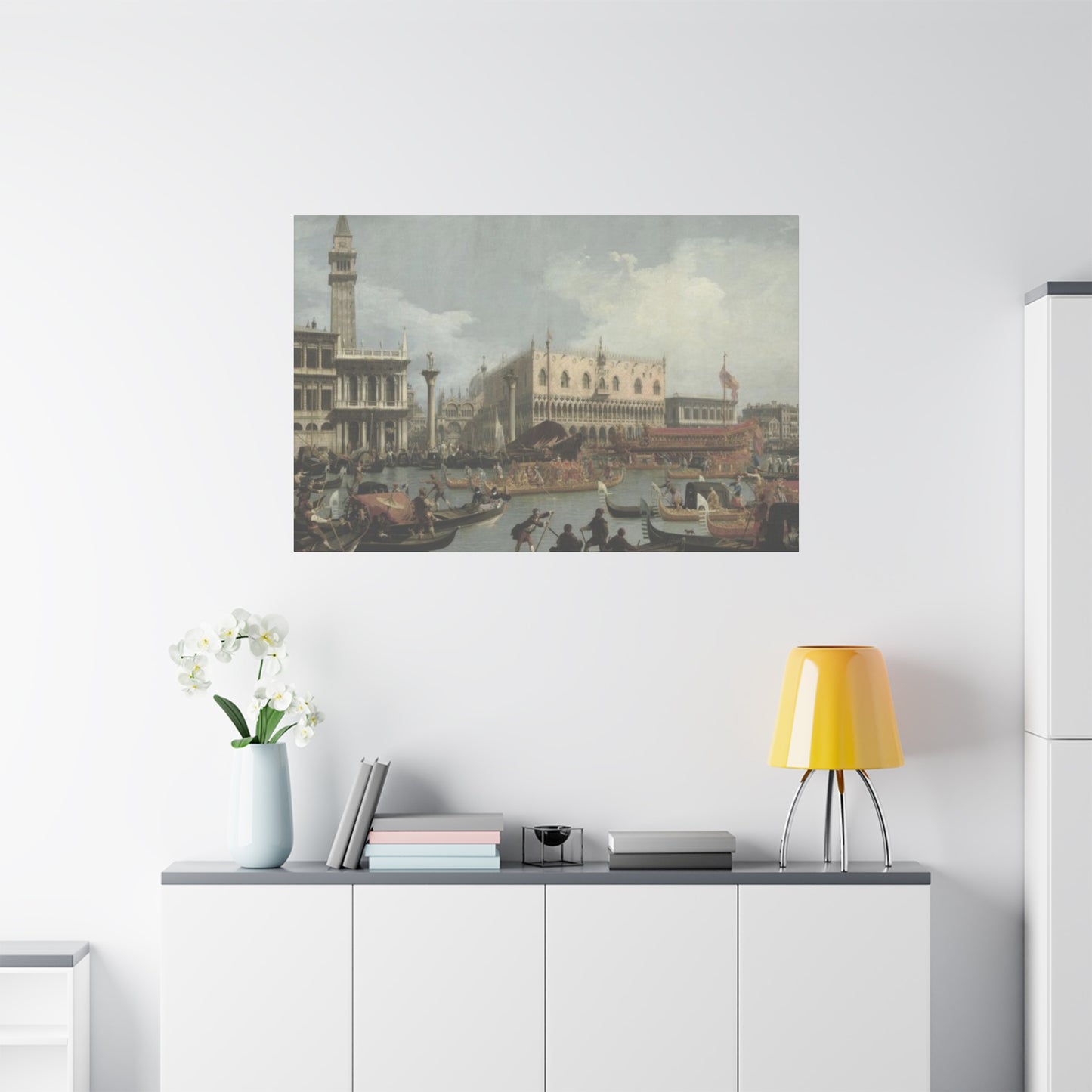Transform Your Home with the Historic Charm of Doge’s Palace Wall Art
The magnificent Doge's Palace stands as one of Venice's most iconic architectural masterpieces, representing centuries of Venetian grandeur and political power. This remarkable Gothic structure, with its distinctive pink and white marble facade and intricate arched galleries, has captivated visitors and artists for generations. Today, homeowners worldwide are discovering the transformative power of incorporating Doge's Palace imagery into their living environments through carefully selected wall art pieces.
The allure of Venetian architecture extends far beyond mere aesthetic appreciation. When you choose to display artwork featuring the Doge's Palace, you're inviting centuries of history, culture, and artistic tradition into your personal living environment. This historic palace, which once served as the residence of the Venetian doge and the seat of government for the Venetian Republic, embodies the perfect fusion of Byzantine, Gothic, and Renaissance architectural elements that continue to inspire contemporary design enthusiasts.
The growing popularity of European landmark artwork in residential settings reflects a broader trend toward incorporating cultural sophistication and worldly elegance into home environments. Doge's Palace wall art offers homeowners an opportunity to create focal points that spark conversation, evoke wanderlust, and demonstrate appreciation for artistic heritage. Whether displayed in living rooms, bedrooms, offices, or dining areas, these pieces serve as windows to one of the world's most romantically beautiful cities.
The versatility of Doge's Palace imagery makes it suitable for various decorating styles and personal preferences. From detailed architectural photography capturing every Gothic arch and ornate detail to impressionistic paintings that emphasize the palace's ethereal beauty reflected in Venetian waters, there are countless ways to incorporate this iconic structure into your home's visual narrative. The palace's distinctive color palette of warm pinks, pristine whites, and rich terracotta tones provides endless inspiration for creating cohesive color schemes throughout your living areas.
Modern printing technologies and artistic interpretations have made it easier than ever to find high-quality reproductions and original artwork featuring the Doge's Palace. Whether you prefer vintage-inspired sepia tones that evoke old-world charm or contemporary interpretations that emphasize bold colors and modern artistic techniques, there are options available to suit every aesthetic preference and budget consideration.
The psychological impact of displaying meaningful artwork in residential environments cannot be overstated. Doge's Palace wall art serves not only as decoration but as a source of daily inspiration, a reminder of travel aspirations, and a connection to the rich cultural heritage of Venice. Many homeowners report that viewing their chosen palace artwork provides a sense of calm sophistication and helps create an atmosphere of refined elegance throughout their living areas.
Venetian Vibes Creating Atmospheric Elegance Through Palace Artwork
Creating an authentic Venetian atmosphere within your home requires more than simply hanging a single piece of palace artwork on the wall. The true magic happens when you carefully consider how Doge's Palace imagery can work in harmony with your existing furnishings, lighting, and overall design aesthetic to create a cohesive and immersive experience that transports viewers to the romantic canals of Venice.
The architectural details of the Doge's Palace offer endless inspiration for creating layered decorative schemes. The palace's famous loggia, with its series of pointed arches and delicate stonework, can inspire the selection of complementary decorative elements such as arched mirrors, wrought iron accessories, or furniture pieces with similar curved lines. The intricate patterns found in the palace's facade can be echoed through textile choices, wallpaper selections, or decorative tile work.
Lighting plays a crucial role in creating authentic Venetian vibes when displaying palace artwork. The soft, diffused light that characterizes Venice, filtered through centuries of maritime mist, should be replicated through carefully chosen lighting fixtures and bulb selections. Warm-toned LED bulbs or soft incandescent lighting can help create the golden glow that makes Doge's Palace imagery appear more luminous and inviting.
Color coordination becomes essential when working with palace-inspired themes. The distinctive pink and white marble of the actual palace provides a sophisticated color palette that can be extended throughout your decorating scheme. Soft rose tones, creamy whites, warm grays, and touches of gold or bronze can create a cohesive visual story that enhances the impact of your chosen palace artwork while maintaining elegance and refinement.
Texture considerations add another layer of authenticity to Venetian-inspired decorating schemes. The weathered stone surfaces, smooth marble details, and aged patina of the actual palace can be referenced through carefully chosen materials and finishes. Distressed wood furniture, aged metal accents, natural stone elements, or fabrics with subtle texture variations can help create the layered, time-worn beauty that characterizes authentic Venetian aesthetics.
The arrangement of furniture and decorative accessories should complement rather than compete with your palace artwork. Consider creating conversation areas that naturally draw attention toward your featured pieces while maintaining comfortable and functional living arrangements. The goal is to create an environment where the artwork feels integrated and essential rather than simply decorative.
Scale and proportion require careful consideration when incorporating palace imagery into residential settings. The massive scale of the actual Doge's Palace must be thoughtfully translated to work effectively in home environments. Large-scale prints can create dramatic focal points in spacious rooms, while smaller pieces might be more appropriate for intimate settings or as part of gallery wall arrangements.
Seasonal adaptability adds another dimension to Venetian-inspired decorating schemes. The changing light conditions in Venice throughout the year can be referenced through adjustable lighting schemes, seasonal textile changes, or rotating artwork displays that emphasize different aspects of palace imagery depending on the time of year.
Gothic Glamour Incorporating Palace Architecture Into Contemporary Living
The Gothic elements of the Doge's Palace offer extraordinary opportunities for creating glamorous and sophisticated living environments that blend historical architectural details with contemporary comfort and style. The palace's distinctive Gothic features, including pointed arches, ornate tracery, and elaborate stone carvings, provide rich inspiration for homeowners seeking to add dramatic flair to their decorating schemes.
Understanding the specific Gothic elements present in the Doge's Palace helps inform decorating decisions that enhance rather than overwhelm your chosen artwork. The palace's unique Venetian Gothic style, which incorporates Byzantine and Islamic influences alongside traditional Gothic elements, creates opportunities for eclectic decorating approaches that celebrate cultural diversity and architectural innovation.
The pointed arch motif, so prominent in palace architecture, can be referenced throughout your home through furniture selections, doorway treatments, window shapes, or decorative accessories. Arched bookcases, curved furniture silhouettes, or architectural elements that echo the palace's distinctive profile help create visual connections that enhance the impact of your palace artwork.
Gothic glamour in contemporary settings requires careful balance between historical references and modern comfort. The key lies in selecting elements that capture the essence of Gothic sophistication without creating environments that feel like museum reproductions. Contemporary furniture with Gothic-inspired details, modern lighting fixtures with medieval references, or artwork that presents Gothic elements through contemporary artistic interpretations can achieve this delicate balance.
Material selections play a crucial role in creating authentic Gothic glamour. The stone and marble elements of the actual palace can be referenced through carefully chosen flooring materials, countertop selections, or decorative accessories. However, these materials should be balanced with softer elements such as luxurious textiles, comfortable seating, and warm lighting to maintain livability and comfort.
The vertical emphasis characteristic of Gothic architecture can be incorporated into residential settings through tall bookcases, floor-to-ceiling window treatments, or vertically oriented artwork arrangements. These elements help draw the eye upward and create the sense of grandeur associated with Gothic architectural traditions while working effectively in standard residential ceiling heights.
Color palettes for Gothic glamour should reflect the rich, sophisticated tones found in medieval palaces while remaining appropriate for contemporary living. Deep jewel tones such as burgundy, emerald, sapphire, or amethyst can be balanced with metallic accents in gold, silver, or bronze to create luxurious color schemes that enhance palace artwork without overwhelming living areas.
Lighting design becomes particularly important when working with Gothic-inspired themes. The interplay of light and shadow that creates such drama in actual Gothic architecture should be referenced through layered lighting schemes that include ambient, task, and accent lighting options. Candles, lanterns, or fixtures with medieval references can add atmospheric touches while maintaining practical functionality.
Textile selections offer opportunities to incorporate Gothic patterns and motifs without overwhelming residential settings. Tapestry-inspired fabrics, rich velvets, or textiles with subtle medieval patterns can reference historical traditions while providing the comfort and warmth essential for contemporary living environments.
Selecting Perfect Frames for Doge's Palace Artwork
The selection of appropriate framing for Doge's Palace artwork requires careful consideration of multiple factors including the artistic style of the piece, the intended display location, and the overall decorating scheme of your home. The frame serves not only as protection for the artwork but as an integral part of the visual presentation that can either enhance or detract from the impact of your chosen palace imagery.
Traditional framing approaches for palace artwork often emphasize ornate, decorative frames that reference historical periods and architectural details. Gilded frames with carved details, frames with Gothic-inspired patterns, or frames that incorporate architectural elements such as columns or arches can create strong visual connections with the palace's own architectural heritage. These traditional approaches work particularly well with classical or historically-inspired decorating schemes.
Contemporary framing options offer different advantages for homeowners seeking to integrate palace artwork into modern living environments. Simple, clean-lined frames in neutral colors allow the artwork itself to take center stage while providing subtle support that doesn't compete for visual attention. These approaches work well when the goal is to highlight the artwork's content rather than create period-specific atmospheric effects.
Material considerations for frames should complement both the artwork and the surrounding environment. Wood frames can provide warmth and natural texture that works well with traditional or casual decorating schemes. Metal frames offer sleek, contemporary appeal that suits modern environments. The specific choice of material should consider factors such as room temperature, humidity levels, and the intended longevity of the display.
Color coordination between frames and surrounding elements requires careful attention to overall visual harmony. Frames should either complement or contrast intentionally with wall colors, furniture finishes, and other decorative elements. The goal is to create cohesive visual relationships that enhance rather than disrupt the overall decorating scheme.
Size considerations for frames must account for both the artwork dimensions and the intended display location. Oversized frames can create dramatic impact in large rooms but may overwhelm smaller environments. Conversely, frames that are too small for their settings may cause the artwork to appear insignificant or lost within the broader decorating scheme.
Matting options provide additional opportunities for customization and visual enhancement. Multiple mat layers can add depth and visual interest while providing color coordination opportunities. The width of mat borders should be proportional to both the artwork size and the frame dimensions to maintain proper visual balance.
Glass or acrylic glazing protects artwork while affecting its visual presentation. Anti-reflective glazing reduces glare issues but may slightly alter color appearance. UV-protective glazing helps preserve artwork from light damage but adds cost considerations. The choice of glazing should balance protection needs with aesthetic preferences and budget constraints.
Professional framing services offer expertise in matching frames to specific artworks and display requirements. While more expensive than ready-made options, custom framing ensures optimal fit, quality materials, and expert advice on preservation and presentation concerns. The investment in professional framing often proves worthwhile for valuable or meaningful artwork pieces.
Conservation framing techniques become important considerations for valuable or irreplaceable palace artwork. Acid-free materials, archival mounting techniques, and museum-quality components help ensure long-term preservation while maintaining optimal visual presentation. These approaches require higher initial investment but provide superior protection and longevity.
Modern Living Areas Enhanced by Historic Venetian Architecture
The integration of historic Venetian architectural imagery into contemporary living areas creates fascinating juxtapositions that celebrate both historical heritage and modern design sensibilities. The Doge's Palace, with its centuries of architectural evolution, provides rich inspiration for homeowners seeking to create sophisticated environments that honor the past while embracing present-day comfort and functionality.
Contemporary open-concept living areas offer unique opportunities for displaying palace artwork in ways that create dramatic focal points while maintaining the flowing, uninterrupted sight lines that characterize modern residential design. Large-scale palace prints can serve as architectural elements themselves, defining different functional areas within open floor plans while providing visual weight and cultural sophistication.
The challenge of incorporating historic imagery into modern settings lies in achieving balance between respect for historical authenticity and contemporary aesthetic preferences. Palace artwork should feel integrated rather than imposed, contributing to the overall design narrative without creating jarring contrasts or overwhelming modern furnishings and architectural elements.
Furniture selection in modern rooms featuring palace artwork requires careful consideration of scale, proportion, and style relationships. Clean-lined contemporary furniture can provide effective contrast to the ornate details of palace architecture, allowing each element to highlight the unique characteristics of the other. The key is selecting pieces that share common elements such as color, material, or proportional relationships.
Technology integration in modern living areas must be handled thoughtfully when historic artwork is featured prominently. Entertainment systems, lighting controls, and other contemporary conveniences should be positioned and designed to complement rather than compete with palace imagery. Hidden or minimally visible technology helps maintain focus on the artistic and cultural elements of the room.
Color schemes in modern rooms with historic artwork often work best when they draw inspiration from the artwork itself while incorporating contemporary color theory and preferences. The warm tones of Venetian architecture can be translated into modern color palettes that feel fresh and current while honoring the historical source material.
Lighting design in contemporary settings with historic artwork requires sophisticated approaches that highlight the artwork effectively while providing appropriate illumination for modern living activities. Track lighting, recessed fixtures, or contemporary pendant lights can be positioned to create dramatic lighting effects that enhance palace imagery while maintaining the clean, uncluttered appearance preferred in modern design.
Material coordination between historic artwork and contemporary furnishings often works best when there are subtle connections rather than obvious matches. Natural materials such as stone, wood, or metal can provide bridges between historic and contemporary elements without creating literal historical reproductions that might feel forced or artificial in modern settings.
Spatial organization in modern rooms should consider the artwork as an integral part of the architectural plan rather than an afterthought. Furniture arrangements, traffic patterns, and functional zones should be planned to optimize viewing angles and create comfortable environments for enjoying the palace imagery while maintaining practical living requirements.
Black and White Palace Photography for Timeless Appeal
Black and white photography of the Doge's Palace offers unique advantages for homeowners seeking artwork that transcends specific decorating trends while providing sophisticated visual impact. The removal of color information allows viewers to focus on the architectural details, proportional relationships, and compositional elements that make the palace such a compelling photographic subject.
The contrast range available in black and white palace photography creates opportunities for dramatic visual effects that work well in various lighting conditions and decorating schemes. High-contrast images with deep blacks and bright whites create bold, graphic effects suitable for contemporary settings, while softer, more graduated tonal ranges provide subtle sophistication appropriate for traditional or transitional decorating approaches.
Historical authenticity finds natural expression through black and white palace imagery, as many of the earliest photographic documentations of Venice were created using monochrome processes. This historical connection adds layers of meaning and cultural significance to contemporary displays while providing visual links to photography's artistic heritage.
Architectural details in the Doge's Palace become particularly striking when rendered in black and white. The intricate stone carvings, ornate tracery, and complex proportional relationships that characterize the palace's facade are often more clearly visible and impactful when color distractions are eliminated. This makes black and white palace photography particularly appealing to viewers interested in architectural appreciation and historical study.
Decorating versatility represents one of the strongest advantages of black and white palace artwork. These pieces can adapt to changing color schemes, seasonal decorating updates, and evolving personal preferences without requiring replacement or major adjustments to surrounding elements. The neutral color palette ensures compatibility with virtually any decorating approach or color preference.
Artistic interpretation in black and white palace photography ranges from documentary-style architectural photography that emphasizes accurate representation to more interpretive approaches that emphasize mood, atmosphere, or abstract compositional elements. Each approach offers different decorating opportunities and appeals to different aesthetic preferences.
Print quality considerations become particularly important with black and white palace photography, as the absence of color makes viewers more sensitive to tonal variations, contrast relationships, and surface textures. High-quality printing processes and papers can enhance the visual impact while ensuring longevity and resistance to fading or other deterioration.
Size considerations for black and white palace prints often favor larger formats that allow viewers to appreciate architectural details and tonal subtleties. However, smaller prints can be effective when grouped in series or incorporated into gallery wall arrangements that create cumulative visual impact through repetition and variation.
Framing approaches for black and white palace photography should emphasize the artwork's tonal relationships and architectural subject matter. Simple, elegant frames often work best, allowing the photography's compositional strength and tonal beauty to take precedence over decorative framing elements.
Creating Focal Points with Palace Architecture Imagery
The strategic placement of Doge's Palace artwork as focal points within residential settings requires careful consideration of viewing angles, lighting conditions, and surrounding decorative elements. Effective focal points draw attention naturally while contributing to the overall visual harmony and functional organization of living areas.
Room layout planning should consider the artwork placement from the earliest design stages rather than treating it as an afterthought. The most effective focal points are positioned where they can be viewed comfortably from multiple seating areas while maintaining appropriate relationships with other room elements such as furniture groupings, lighting fixtures, and architectural features.
Scale relationships between palace artwork and surrounding elements must be carefully balanced to create focal points that command attention without overwhelming their settings. Large-scale pieces require sufficient wall area and visual breathing room to be appreciated fully, while smaller pieces may need grouping or strategic placement to achieve focal point status.
Background considerations affect the visual impact of palace artwork significantly. Wall colors, textures, and patterns should be selected to enhance rather than compete with the artwork. Neutral backgrounds often work best for allowing architectural details and compositional elements to appear clearly and dramatically.
Lighting design plays a crucial role in establishing effective focal points with palace artwork. Dedicated artwork lighting, whether through picture lights, track lighting, or strategically positioned accent fixtures, helps separate the artwork visually from its surroundings while creating dramatic effects that enhance viewing pleasure.
Complementary elements can be used to strengthen focal point effects while maintaining visual balance. Decorative accessories, furniture placement, or architectural treatments that echo themes or colors from the palace artwork help create cohesive visual stories that enhance overall impact without creating overwhelming or chaotic effects.
Seasonal considerations allow homeowners to adjust the emphasis and impact of palace artwork focal points through coordinated changes in surrounding elements. Lighting adjustments, accessory changes, or textile updates can refresh the appearance and impact of established focal points without requiring major redecorating efforts.
Viewing distance requirements should be considered when establishing palace artwork as focal points. Detailed architectural photography requires closer viewing distances for full appreciation, while impressionistic or abstract interpretations may be effective from greater distances. Room layouts should accommodate appropriate viewing distances while maintaining comfortable furniture arrangements.
Multiple focal point strategies can work effectively in larger rooms or open-concept areas where single focal points might be insufficient. Palace artwork can be coordinated with other focal elements such as fireplaces, architectural features, or furniture groupings to create layered visual interest that guides attention throughout the room.
Romantic Italian Atmosphere Through Venetian Wall Art
Creating romantic Italian atmosphere through carefully selected Venetian wall art requires understanding the cultural, historical, and aesthetic elements that contribute to Italy's reputation as one of the world's most romantic destinations. The Doge's Palace, with its fairy-tale architecture and waterside setting, embodies many of the qualities that make Venice synonymous with romance and beauty.
Emotional connections to Italian culture and Venice specifically can be enhanced through thoughtful selection and presentation of palace artwork. Pieces that capture the golden light of Venetian sunsets, the reflection of palace architecture in canal waters, or the intimate scale of palace details can evoke the personal, emotional responses associated with romantic travel experiences and cultural appreciation.
Color psychology plays an important role in creating romantic atmospheres through Italian-themed artwork. The warm tones characteristic of Venetian architecture, including soft pinks, creamy whites, and golden yellows, naturally create feelings of warmth, comfort, and emotional connection. These colors can be extended throughout decorating schemes to enhance the romantic impact of palace artwork.
Artistic styles that emphasize softness, light, and atmospheric effects tend to work best for creating romantic Italian themes. Impressionistic paintings, soft-focus photography, or artwork that emphasizes the interplay of light and water can create dreamy, romantic effects that transport viewers emotionally to Venice's most beautiful and intimate moments.
Intimate scaling in artwork selection and display helps create the personal, romantic atmosphere associated with Italian culture. While dramatic large-scale pieces have their place, smaller, more intimate artworks often create stronger emotional connections and more successful romantic atmospheres in residential settings.
Complementary decorative elements can strengthen romantic Italian themes when coordinated thoughtfully with palace artwork. Soft textiles, gentle lighting, fresh flowers, or accessories that reference Italian cultural traditions can create layered atmospheric effects that enhance the emotional impact of the artwork itself.
Personal meaning and connection become particularly important when creating romantic atmospheres through Italian artwork. Pieces that commemorate personal travel experiences, celebrate anniversaries or special occasions, or represent shared cultural interests create stronger emotional connections than purely decorative selections.
Seasonal adaptability allows homeowners to adjust romantic Italian themes throughout the year while maintaining core decorative elements. Spring and summer presentations might emphasize bright, airy effects, while autumn and winter displays could focus on warmer, more intimate atmospheric qualities.
Lighting design for romantic Italian themes should emphasize warmth, softness, and gentle illumination rather than bright, harsh effects. Candles, warm-toned bulbs, and dimmer controls help create the intimate lighting conditions that enhance romantic atmospheres while showing palace artwork to best advantage.
Capturing Waterfront Perspectives of Palace Architecture
The waterfront setting of the Doge's Palace provides endless inspiration for artwork that captures the unique beauty of Venetian architecture reflected in canal waters, framed by changing skies, and viewed from the romantic perspective of gondolas and water taxis. These waterfront perspectives offer different emotional and aesthetic qualities compared to land-based architectural photography.
Water reflections create magical effects in palace imagery that add depth, movement, and visual interest to static architectural subjects. The broken, impressionistic qualities of architectural reflections in canal waters provide softer, more romantic alternatives to sharp, documentary-style architectural photography while maintaining clear connections to the palace's distinctive features.
Changing light conditions throughout the day create different moods and atmospheric effects in waterfront palace imagery. Dawn and dusk photographs capture golden, romantic lighting that emphasizes the palace's warm-toned architecture, while midday shots provide clear, detailed views of architectural elements and proportional relationships.
Seasonal variations in waterfront palace imagery offer opportunities for creating dynamic, changing displays that reflect Venice's different seasonal personalities. Summer scenes with bright blue skies and clear water contrasts create fresh, energetic effects, while winter scenes with moody skies and choppy waters provide more dramatic, contemplative atmospheres.
Compositional approaches for waterfront palace imagery can emphasize different aspects of the Venice experience. Wide shots that include extensive water areas and sky create expansive, peaceful effects, while closer compositions that focus on architectural details with water elements provide more intimate, detailed perspectives.
Movement and activity in waterfront palace scenes add life and energy to static architectural subjects. Gondolas, water taxis, or people moving through the scenes create dynamic elements that prevent the artwork from feeling static or purely documentary while adding human scale and cultural context.
Weather effects in waterfront palace imagery create opportunities for dramatic atmospheric presentations. Storm clouds, fog, rain effects, or bright sunshine each contribute different emotional qualities and visual impacts that can be selected to match intended decorating themes and personal preferences.
Perspective variations from water level viewpoints offer unique compositional opportunities not available in land-based palace photography. Low viewpoints from boat level create dramatic upward perspectives that emphasize the palace's imposing scale and architectural grandeur while including intimate water-level details.
Technical considerations for waterfront palace imagery include challenges related to light reflection, color balance, and atmospheric effects that require skilled photography or artistic interpretation. High-quality reproductions should maintain the subtle color relationships and atmospheric effects that make waterfront palace imagery particularly compelling.
Vintage Versus Modern Artistic Interpretations of Palace Architecture
The choice between vintage and modern artistic interpretations of Doge's Palace architecture creates significantly different decorating opportunities and appeals to different aesthetic preferences and cultural perspectives. Understanding the characteristics and advantages of each approach helps homeowners make informed decisions that align with their personal taste and decorating objectives.
Vintage interpretations of palace architecture often emphasize historical authenticity, traditional artistic techniques, and connections to earlier periods of travel and cultural documentation. These approaches may include sepia-toned photography, traditional printmaking techniques, or artistic styles that reference historical periods such as romanticism or orientalism.
Historical accuracy in vintage palace interpretations provides cultural and educational value while creating connections to earlier periods of Venetian history and international appreciation. These pieces often serve as windows into past eras while maintaining contemporary relevance through their continued aesthetic appeal and cultural significance.
Nostalgic qualities inherent in vintage palace artwork create emotional connections that transcend purely aesthetic considerations. Many viewers respond positively to artwork that evokes memories of earlier travel experiences, family history, or cultural traditions while providing visual pleasure and decorating impact.
Aging effects and patina characteristics of genuine vintage palace artwork add authenticity and character that cannot be replicated through modern reproduction techniques. However, high-quality reproductions of vintage pieces can capture many of these qualities while providing better availability and affordability for contemporary homeowners.
Modern interpretations of palace architecture offer contemporary perspectives that can make historic subjects feel fresh and relevant to current cultural contexts. These approaches might include contemporary photographic techniques, modern artistic mediums, or interpretive approaches that emphasize abstract or conceptual elements.
Technical innovations in modern palace artwork include high-resolution digital photography, advanced printing techniques, and contemporary artistic mediums that can capture details and create effects not available to earlier generations of artists and photographers. These technical advantages can result in superior visual quality and longevity.
Contemporary artistic perspectives on palace architecture can reveal new aspects of familiar subjects while maintaining connections to historical and cultural significance. Modern artists may emphasize different architectural elements, explore new compositional approaches, or incorporate contemporary aesthetic theories that create fresh interpretations.
Decorating integration considerations differ significantly between vintage and modern palace interpretations. Vintage pieces often work best with traditional or eclectic decorating schemes, while modern interpretations may be more suitable for contemporary or transitional settings. However, successful mixing of vintage and modern elements can create sophisticated, layered decorating effects.
Investment considerations may favor vintage palace artwork that has established provenance and historical significance, while modern pieces may offer better availability, condition, and affordability for most homeowners. The choice often depends on budget considerations, collecting objectives, and personal preferences regarding authenticity versus accessibility.
Gallery Wall Concepts Featuring Venetian Palace Imagery
Creating successful gallery walls that feature Doge's Palace imagery requires careful planning, coordination, and attention to visual balance and proportional relationships. Gallery walls offer opportunities to display multiple pieces while creating cumulative visual impact that individual artworks might not achieve independently.
Planning and layout considerations for palace-themed gallery walls should begin with accurate measurements and paper templates that allow experimentation with different arrangements before committing to final placement. The goal is to create balanced, harmonious groupings that feel intentional and cohesive rather than random or overwhelming.
Size variation within gallery walls creates visual interest and prevents monotonous effects while maintaining overall balance and proportion. Mixing larger focal pieces with smaller supporting artworks, varying frame sizes, and including different artistic mediums can create dynamic gallery walls that reward close examination and repeated viewing.
Theme coordination in palace-focused gallery walls can emphasize different aspects of Venetian architecture and culture while maintaining visual unity. Walls might focus on architectural details, water views, seasonal variations, or historical periods while using consistent framing, color schemes, or artistic approaches to create coherence.
Frame coordination strategies for gallery walls range from matching frames throughout for formal, unified effects to mixing frame styles for more eclectic, collected-over-time appearances. Consistent frame colors or materials can provide unity while allowing variation in sizes and styles.
Color coordination across multiple pieces requires attention to overall balance and visual harmony. Palace imagery naturally includes consistent color elements, but additional coordination through mat colors, frame finishes, or surrounding wall treatments can enhance the gallery wall's effectiveness.
Spacing and alignment guidelines help create professional-appearing gallery walls that feel balanced and intentional. Generally, consistent spacing between pieces, aligned edges or centers, and consideration of eye-level viewing heights contribute to successful arrangements.
Lighting considerations for gallery walls require careful attention to even illumination across all pieces while avoiding glare or shadow problems. Track lighting, multiple picture lights, or carefully positioned accent fixtures can provide appropriate lighting for gallery wall arrangements.
Evolution and updating strategies allow gallery walls to grow and change over time as collections expand or decorating preferences evolve. Initial arrangements should allow for future additions while maintaining the flexibility to rearrange or substitute pieces as desired.
Styling Venetian Architecture Prints in Various Home Settings
The successful integration of Venetian architecture prints into different home settings requires understanding the unique characteristics and requirements of various rooms while adapting presentation strategies to match functional needs and aesthetic goals. Each room type offers different opportunities and challenges for displaying palace imagery effectively.
Living room presentations of palace prints often work best as focal points or conversation pieces that can be viewed and appreciated by multiple people simultaneously. Large-scale pieces or gallery wall arrangements work well in living areas where they can serve as central decorative elements while complementing furniture arrangements and entertainment functions.
Bedroom displays of Venetian architecture imagery should emphasize calming, romantic, or personally meaningful aspects that contribute to restful, intimate atmospheres. Softer artistic interpretations, smaller scales, or placement positions that can be enjoyed from bed or seating areas work best in bedroom settings.
Dining room installations can take advantage of the formal, cultural associations of palace architecture while creating sophisticated backgrounds for entertaining and family meals. Dramatic lighting effects and larger scale pieces can work well in dining areas where they contribute to special occasion atmospheres.
Home office integration of palace prints can provide inspiration and cultural sophistication while maintaining professional appropriateness for video calls or client meetings. Clean, architectural interpretations or sophisticated black and white pieces often work best in office settings.
Kitchen and casual area applications require consideration of practical factors such as moisture, temperature variations, and cleaning requirements while maintaining aesthetic appeal. Properly framed and protected palace prints can work well in these areas when positioned away from direct heat and moisture sources.
Hallway and transitional area displays offer opportunities to create gallery-like progressions that guide visitors through homes while showcasing palace imagery. Series of related pieces or coordinated arrangements can create compelling visual narratives in circulation areas.
Bathroom applications require special consideration of humidity and moisture protection while creating spa-like or luxurious atmospheres. Properly sealed frames and moisture-resistant materials allow palace imagery to enhance bathroom environments safely.
Guest room presentations can showcase palace imagery as welcoming, cultural elements that demonstrate hospitality and worldly sophistication. Pieces that evoke travel and cultural appreciation can help guests feel welcomed while providing conversation starters and cultural interest.
Stairway installations take advantage of vertical wall areas while creating dramatic effects that can be viewed from multiple levels. Careful consideration of viewing angles and lighting ensures that stairway palace displays work effectively from different positions.
Art Enthusiast's Approach to Palace-Themed Home Decoration
Serious art collectors and enthusiasts approach palace-themed home decoration with different priorities and considerations compared to casual decorators. Understanding these perspectives can help homeowners make more informed decisions while developing deeper appreciation for the cultural and artistic significance of their chosen artwork.
Artistic merit evaluation requires understanding the different criteria used to assess palace artwork quality and significance. Technical excellence, compositional strength, historical importance, and artistic innovation all contribute to overall artistic value and long-term satisfaction with chosen pieces.
Historical context and cultural significance add layers of meaning and appreciation to palace artwork that extend beyond purely aesthetic considerations. Understanding the palace's role in Venetian history, its architectural significance, and its representation in different artistic periods enhances the viewing experience and personal connection to the artwork.
Artist research and provenance considerations become important factors for collectors seeking investment-quality pieces or artwork with established artistic significance. Understanding artist backgrounds, exhibition histories, and market recognition helps inform purchasing decisions and collection development strategies.
Conservation and preservation concerns require attention to proper framing, display conditions, and long-term care strategies that protect artwork value while maintaining optimal viewing conditions. Museum-quality materials and professional conservation advice become important considerations for valuable pieces.
Collection development strategies help art enthusiasts build coherent, meaningful collections over time rather than making random individual purchases. Focusing on specific themes, time periods, artistic techniques, or geographic perspectives can create more satisfying and valuable collections.
Exhibition and display techniques borrowed from museum and gallery practices can enhance home presentations while protecting artwork value and significance. Professional lighting, climate control, and security considerations may be appropriate for valuable collections.
Educational and cultural engagement opportunities arise from serious art collecting and can enhance personal knowledge while contributing to broader cultural appreciation. Participating in art organizations, attending exhibitions, or supporting cultural institutions can deepen understanding and enjoyment.
Investment considerations may influence artwork selection for collectors interested in financial as well as aesthetic returns. Market research, price trends, and expert advice can inform purchasing decisions while maintaining focus on personal enjoyment and aesthetic satisfaction.
Documentation and cataloging practices help collectors maintain records of their collections while preserving information about provenance, condition, and significance for insurance, estate planning, or future sale considerations.
Color Palette Inspiration Drawn from Venice Architecture
The distinctive color palette of Venetian architecture, exemplified by the Doge's Palace, provides rich inspiration for creating cohesive home decorating schemes that honor the beauty and sophistication of this iconic building. Understanding and applying these color relationships can transform ordinary rooms into sophisticated environments that celebrate Venetian aesthetic traditions.
Primary colors in Venetian palace architecture include the distinctive pink and white marble that gives the Doge's Palace its famous appearance. These warm, sophisticated tones provide an excellent foundation for decorating schemes that seek to capture Venetian elegance while remaining suitable for contemporary living environments.
Secondary color elements found in palace imagery include the warm terracotta tones of roofing materials, the soft grays and blues of weathered stone elements, and the golden tones that appear in architectural details and decorative elements. These colors can be incorporated as accent tones that enhance the primary palette while adding depth and visual interest.
Seasonal color variations in Venetian architecture provide opportunities for evolving decorating schemes that maintain core color relationships while adapting to different times of year or changing personal preferences. The warm, golden light of summer can inspire brighter, more energetic color applications, while the softer, more muted light of winter suggests subtler, more contemplative approaches.
Water reflection effects create additional color opportunities that can be incorporated into Venice-inspired decorating schemes. The blues and greens reflected in canal waters, combined with the shifting, broken color effects created by water movement, suggest sophisticated color layering techniques that can add complexity and visual interest to residential color schemes.
Complementary color relationships based on traditional color theory can enhance Venice-inspired palettes while maintaining visual harmony and balance. Understanding which colors work well with the pink and white tones of palace architecture helps inform decisions about accent colors, textile selections, and decorative accessories.
Neutral color integration allows Venice-inspired color schemes to work effectively with existing furnishings and architectural elements while providing flexibility for future changes or additions. Sophisticated neutral tones can provide background support for more distinctive Venetian colors while maintaining overall visual coherence.
Metallic accent opportunities arise naturally from the golden and bronze tones found in Venetian architectural details, lighting fixtures, and decorative elements. These metallic accents can be incorporated through hardware selections, lighting fixtures, or decorative accessories that enhance the overall sophistication of Venice-inspired color schemes.
Textile and pattern applications of Venetian color palettes can extend the decorating theme throughout home environments while providing comfort and softness that balance the harder edges of architectural elements. Fabrics, wallpapers, and floor coverings in Venice-inspired colors help create immersive environments that celebrate Italian aesthetic traditions.
Lighting effects on Venice-inspired color schemes require careful consideration of how different lighting conditions affect color appearance and relationships. Warm-toned lighting generally enhances Venetian color palettes, while cooler lighting may diminish their effectiveness or create unwanted color shifts.
Conclusion
Doge’s Palace Wall Art offers a timeless glimpse into the grandeur and elegance of historic Venice, transforming any living space into a refined celebration of art, architecture, and cultural heritage. This iconic landmark, known for its intricate Gothic design and storied past, becomes the centerpiece of your home’s décor through carefully crafted artwork that captures its majestic beauty and atmospheric charm. More than just a visual element, Doge’s Palace art brings history to life, inviting viewers to experience the romance and sophistication of Venetian culture.
The appeal of Doge’s Palace Wall Art lies not only in its detailed representation of architectural splendor but also in its ability to evoke a sense of place and time. Whether depicted in vivid, realistic detail or through artistic interpretations that emphasize light, shadow, and texture, these pieces offer an elegant narrative that enriches your interior space. They complement a variety of décor styles, from classic and traditional to contemporary settings that appreciate historical references with a modern twist.
Incorporating Doge’s Palace imagery into your home introduces an atmosphere of cultured sophistication and timeless grace. It serves as a reminder of Venice’s enduring influence on art, architecture, and history, while also sparking curiosity and admiration for one of the world’s most enchanting cities. This wall art becomes more than decoration—it’s a window into a rich cultural legacy that resonates deeply with those who appreciate beauty, history, and artistry.
Ultimately, Doge’s Palace Wall Art is a tribute to Venetian elegance and an invitation to bring that historic grandeur into your daily living experience. It adds depth, character, and a refined aesthetic that transforms ordinary walls into stories of art, heritage, and timeless charm.



















